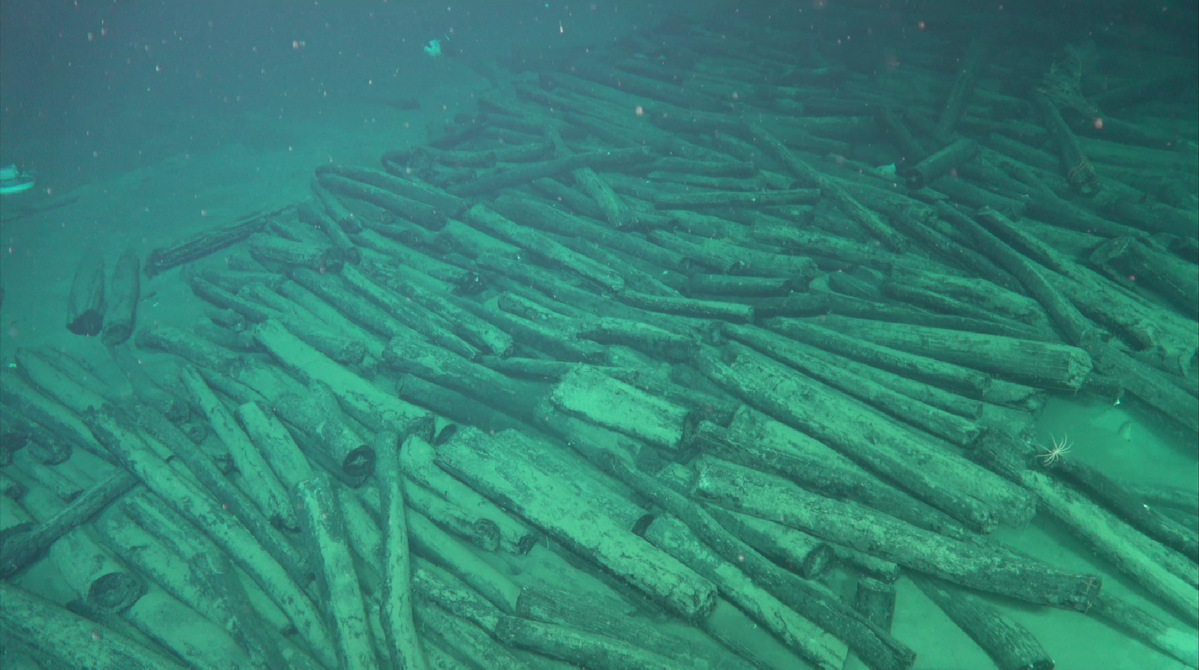

A scientific research team of Institute of Deep-sea Science and Engineering with the Chinese Academy of Sciences first found the two shipwrecks on a continental slope in October. It is also the first time that China discovered a site of large-scale ancient shipwreck in deep sea.
The two are named by researchers as Northwest Continental Slope No 1 and No 2 Shipwrecks in South China Sea.
According to Yan Yalin, director of archaeology department of the National Cultural Heritage Administration, preliminary investigation showed relics from the No 1 shipwreck were scattered across about a 10,000-square-meter area. It is estimated that over 100,000 cultural relics, mainly porcelains, are sealed on the spot. Most of the shipwreck is still buried in sand, and some parts are covered by a 3-odd-meter-thick layer of relics.
On the No 2 shipwreck, about 20 kilometers away, numerous processed wooden logs are neatly placed, together with small number of ceramics.
Based on some porcelains that were salvaged from the sites, the No 1 shipwreck was probably from reign of Zhengde (1505-21), and the No 2 was from reign of Hongzhi (1488-1505).
"The well-reserved relics are of high historical, scientific, and artistic values," Yan said. "It can be a world-class archaeological discovery in deep sea.
"The findings are key evidences of ancient Maritime Silk Road and is a major breakthrough studies for history of Chinese overseas trade, navigation, and porcelains," he added.
Products of Jingdezhen, Jiangxi province and Longquan Kiln in present-day Zhejiang province, both key hubs for porcelain making and export of ancient China, dominated the discovered porcelains on the No 1 site.
According to a video clip publicly revealed by its research team on Sunday, varieties including blue-and-white porcelains, celadons, and ceramics with green glaze were found on the site.
While archaeologists speculated the wooden logs on the No 2 shipwreck may indicate its nature of import trade as timber was recorded on the list of imports in ancient Chinese documentation of its time.
Tang Wei, director of the National Centre for Archaeology, which is affiliated to the cultural heritage administration, said new discoveries provided key references for understanding changing historical trade routes across the South China Sea.
"Discovery of inbound and outbound ancient ships in the same area demonstrated significance of this route," Tang said. "It helped studies on reciprocal flow of Maritime Silk Road."
The first-round detailed underwater investigation of the sites was officially launched on Saturday, and will last until June.

The "permanent surveying base point" is set on the seabed near No 1 Shipwreck on May 20. Photo provided to China Daily
To protect the relics, exact location of the two shipwrecks had not been released, but Yan said a metal marker, or a "permanent surveying base point", was set on the seabed on Saturday by the No 1 shipwreck on Saturday as the benchmark to facilitate future research in the region.
The project is conducted by about 30 researchers from the National Centre for Archaeology, Institute of Deep-sea Science and Engineering, and China (Hainan) Museum of South China Sea.
Science ship Tansuo-1 and submersible Shenhai Yongshi, or Deep-sea Warrior, had taken researchers for earlier exploration. Chen Chuanxu, a scientist from the Institute of Deep-sea Science and Engineering said another vessel Tansuo-2 and submersible Fendouzhe, or Striver, will join.
Many new technologies were used in this highlighted project.
For example, soft robotics referring to bionics and material science was adopted in salvaging of the relics to ensure safety. Other new technical approaches had also been used for scanning, photography, and supervision surrounding the shipwrecks.
"Speaking of protecting and having real-time monitoring of such large underwater sites in situ 1,500 meters below the sea level, we have no previous example to learn from in the world," Chen said, adding that the researchers now try to do so via live video.
Estimated 50 diving trips will be made by the submersibles within the next year in three phrases, according to Song Jianzhong, a researcher with the National Centre for Archaeology.
"Figuring out condition of the shipwrecks, we can then draft future plans of archaeological excavation and conservation," Song said.
He added that the upcoming research will also cover studies of geophysical, geology, marine life, and so on.
China's underwater archaeology used to mainly focus on shallow sea and areas close to islands and reefs. The situation began to change since 2018, when the National Centre for Archaeology and Institute of Deep-sea Science and Engineering co-founded a laboratory for deepwater archaeology.
In 2022, the joint team found another group of cultural relics including Chinese coins ranging from Tang (618-907) to Qing (1644-1911) dynasties, on a spot about 2,100 meters below the sea level near Xisha Islands.
"China will also promote international cooperation in protection of underwater cultural relics and share our experiences," Yan said. (chinadaily.com.cn)

Neatly placed wooden logs are found on Northeast Continental Slope No 2 Shipwreck of the South China Sea. Photo provided to China Daily

Submersible Shenhai Yongshi is seen during an exploration mission on the newly found shipwrecks. Photo provided to China Daily

86-10-68597521 (day)
86-10-68597289 (night)

52 Sanlihe Rd., Xicheng District,
Beijing, China (100864)

